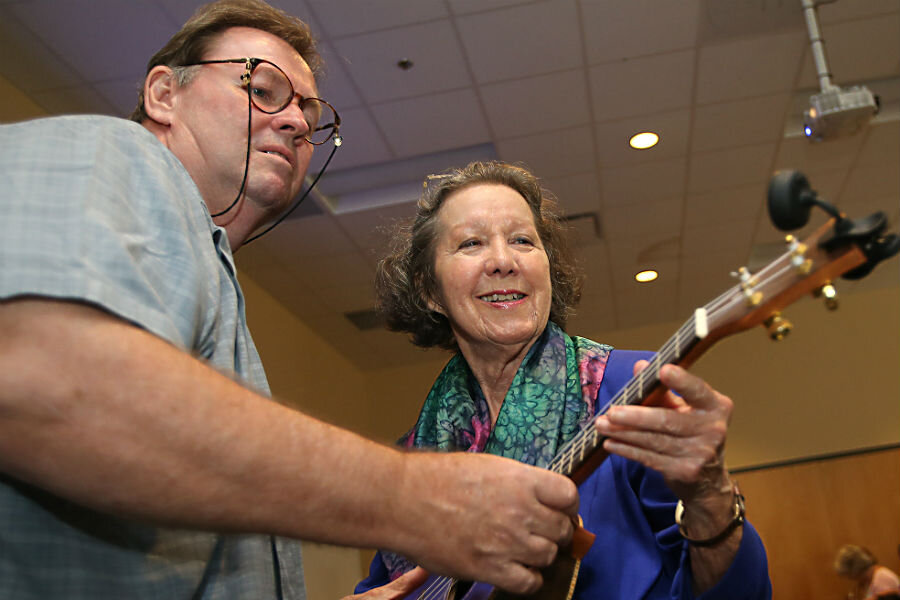Free bikes and tubas? How Helsinki is rebooting social connection
Loading...
Helsinki is home to a vibrant example of "participatory urban culture" where residents can exit the digital world and find the tools in the library (everything from bicycles to banjos) to engage with others.
In a sense, the Finnish capital is following in the footsteps of American libraries which have long loaned everything from hand tools to hamsters. But the libraries are just part of a broader cultural expression.
Spontaneous street food, art, and music can also be found in Helsinki. It's sort of a Burning Man Festival in an urban setting – in part as a response to the time residents now spend tethered to a digital device. It's a push to reengage with neighbor and community.
And Helsinki's public libraries are both catalyst and cradle.
These city institutions now offer free rentals of items such as sewing machines, bikes, pieces of art, outdoor social games and traditional musical instruments. A “pop-up library bike” roams the city offering reading material, performance art, and advice for outdoor activities.
Residents of Helsinki also enjoy an annual tradition of "Dinner under the sky" where people step away from their laptops to go outside to the city’s sidewalks, parks, and bustling streets to setup tables and dine together.
A participatory urban culture is defined as one that lowers barriers to artistic expression and civic engagement, while supporting creative commons (the free sharing of intellectual property for the greater advancement of society), and add a dash of informal mentoring via peer-to-peer learning.
“What Helsinki is doing creates a sense of belonging through participation,” Alex Benay, president and CEO, Canada Science and Technology Museums says in a telephone interview, “Science is participatory in nature. Culture should be as well," he says.
Julie Todaro, president-elect of the American Library Association (ALA), says in a telephone interview, “I don’t want to sound U.S.-centric, but as long as people have been in libraries we have checked out unusual things. But it goes in waves.”
“Communities need different things in different times,” Ms. Todaro says. “When I first started out in libraries people were checking out small animals so families could learn how to take care of a pet, or have a companion animal.”
During the gentrification movement in cities, she adds, libraries stocked gardening and power tools.
According to Todaro the hottest trends in libraries in America today include Maker Spaces, seed exchange check-outs, self-publishing facilities with book binding machines, and libraries allowing small businesses to check out office space.
While American libraries have had the participatory urban cultural model in house for some time, Helsinki is poised to expand it into a city-wide playground environment by drawing on the reach of social media. The two worlds coexist and can reinforce this urban blueprint.
"We do live in a digital world and one of the things to keep in mind for Helsinki is that these efforts are supported in some way shape or form by digital media because the easiest way to engage with people these days is on your phone,” Benay adds.
Aleksi Neuvonen, head of research for the Finnish cultural think tank Demos Helsinki, says “there are couple of explanations why this is working in Finland: high aesthetic quality and design of public space, both outdoors and indoors, makes people feel comfortable using public assets and engaging with each other.”
Mr. Neuvonen suggests that the success of this kind of participatory culture may be in part because of “a wide use of public services by the middle-class (like public libraries) are part of the explanation as well.”
The Youtube and the maker movement taking American libraries by storm are two examples of how online participation merges with urban and hands-on techno-culture.
“The open access movement in science, software or coding seems to be a good example of people working for the benefit of the commons,” Prof. Keith Campbell, head of the department of psychology, University of Georgia in Athens, and author of "The Narcissism Epidemic: Living in the Age of Entitlement" writes in an email.
“I would very much support any efforts to support offline participation, especially for young people. Yes to more Maker Spaces and bikes!” writes Sonia Livingstone, a professor of social psychology in the Department of Media and Communications at the London School of Economics, in an email to the Monitor.
Professor Livingstone, who is also a fellow and past president of the International Communication Association, adds, “Being there in person is definitely significant as it activates all the senses and permits an embedded commitment to the event that is compelling and often long-lasting.”
The maker movement bridges the gap between sharing plans and technology online that are later used in physical maker spaces to create new designs and products.
Neuvonen says that US cities can learn from the success of Helsinki, but some cultural and physical changes would have to come first.
“Having public services like public libraries to encourage sharing things and encouraging meeting people is needed,” he explains. “It takes institutions encouraging that. It takes less fear of meeting strangers. You also need spaces that are welcoming to create an atmosphere where people themselves create confidence, not security systems or guards. I think we need something to balance the isolation of the online world. We need to be less cut-off.”
Todaro suggests that those who wish to see more hamsters, tubas, and maker spaces available for their use unite with a local church, home, school, or community group to identify needs in their area and then go to their local library with suggestions.
“Libraries are only as clever as the communities they serve,” Todaro says. “These acquisitions are not by geographic region as economic region. Libraries need to know where they can lean in more. Libraries have always filled that void.”








